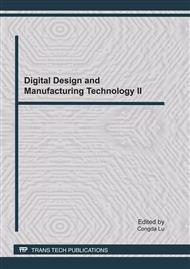p.295
p.300
p.305
p.310
p.315
p.320
p.327
p.332
p.336
Fixture Design Based on Magneto-Rheological Fluids for Thin Wall Spherical Shell Precision Machining
Abstract:
Thin wall spherical shell is easy to deform at the process of turning because the low rigidity. In order to improve process precision of the thin wall spherical shell, the thought increasing the workpiece technology stiffness is put forward, which the magneto-rheological fluids (MRF) is filled inside the thin wall spherical shells as strengthening phase transition material. In magnetic field, MRF can transform from fluid to solid and solid back to fluid rapidly. According to the thought, the fixture designed is applicable for the thin wall spherical shells process precision. The clamp stiffness can be controlled and the MRF can be used many times. In order to get uniform intensity of the magnetic field in MRF, the special magnetic device is designed which is based on the variable MRF thickness and the magnetic field distributing is analyzed and optimized. The fixture based on MRF will help to improve machining precision of the thin wall spherical shells.
Info:
Periodical:
Pages:
315-319
Citation:
Online since:
March 2011
Authors:
Price:
Сopyright:
© 2011 Trans Tech Publications Ltd. All Rights Reserved
Share:
Citation:


